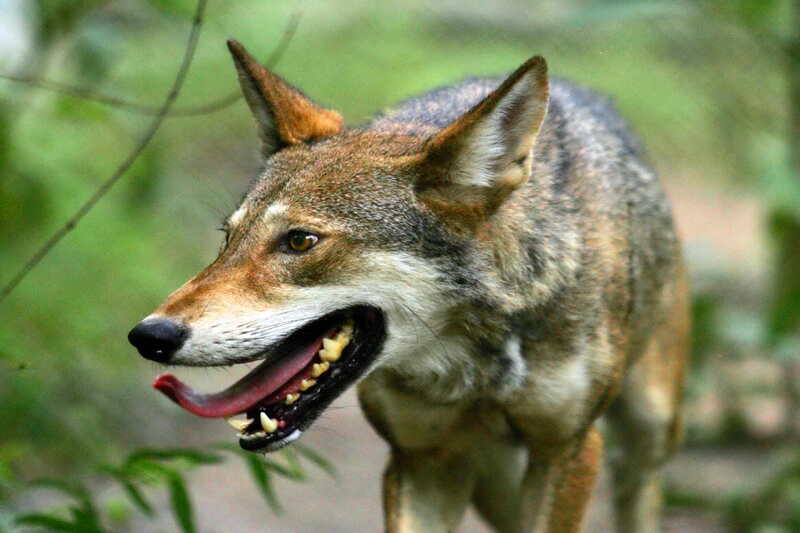The US Fish and Wildlife Service is facing legal action after being accused of not taking enough direct action to help the struggling red wolf population flourish in the wild. The Southern Environmental Law Center is representing the Animal Welfare Institute, Defenders of Wildlife as well as Red Wolf Coalition to sue the USFWS. The iconic red wolf has become one of the most endangered canids in the world, with fewer than 20 left within the wild.
—
North Carolina’s Alligator River Mountain Refuge is the last remaining natural habitat of the red wolf, overall covering 250 000 acres. Of the remaining population, 7 are tracked through radio collars within northern-eastern North Carolina, while 10 others have been seen within the same territory. No wild litters have been found within the last two years, the first time this has happened since 1988.
The USFWS has spearheaded the Red Wolf Recovery Project since the 1970s to enable the species to increase, initially showing promising results. The project captured red wolves from 1973 through to 1980 to form the first captive breeding programme at Point Defiance Zoo and Aquarium in Tacoma, Washington. The few pure breeds that were discovered (14 out of 43 given to the programme, the remainder being coyote hybrids) were then used to rebuild the population. In 1980, the red wolf was declared extinct within the wild. The success of the programme allowed four pairs of red wolves to enter Alligator River Mountain Refuge in 1987 and by the late 2000s there were an estimated 130 red wolves out of captivity. However, the species has continued to decline ever since and the USFWS is being blamed for the continued downturn.
You might also like: Lack of Protection Leaves Spain-Size Swath of Brazilian Amazon Up for Grabs
The Southern Environmental Law Center alongside the three wildlife organisations brought the lawsuit to fruition to proclaim that the USFWS is violating the Endangered Species Act regarding new policies that prohibit proven management strategies being carried out within the red wolves’ natural habitat. This includes a halt of the USFWS coyote sterilisation programme within Alligator River Mountain Refuge, which is designed to prevent further dilution of the red wolf bloodline, as well as reduce releases of previously captive wolves as a part of the USFWS Red Wolf Recovery Program Adaptive Work Plan. “The Fish and Wildlife Service is managing this species for extinction,” stated Sierra Weaver, senior attorney with the Southern Environmental Law Center. “Faced with a wild population of only seven known animals, the Fish and Wildlife Service is now claiming- without basis- that it’s not allowed to take proven, necessary measures to save the wild red wolves. The service urgently needs to restart red wolf releases from captivity, which it did regularly for 27 years. Otherwise we’re going to lose the world’s only wild population of this wolf.” The Southern Environmental Law Center claims that USFWS have created a new, illegal policy which suggests the agency is no longer permitted to release captive red wolves into the wild nor continue with coyote sterilisation in an attempt to abandon the process of reviving the species.
The red wolf population (tens of thousands prior to the 17th century) previously spanned across the US, from the state of Missouri to as far south as central Texas. But European settlers considered the wolf breed to be a pest, and from the 1600s to the early 1900s, the red wolves were routinely killed. In recent years, some of the biggest challenges red wolves have faced include hybridisation, habitat degradation, shootings and a lack of education on the breed. Defenders of Wildlife also highlight agency mismanagement from USFWS as another challenge. Last year, the Center for Biological Diversity took the USFWS to court over a lack of planning to save the species from the brink of extinction. The Center for Biological Diversity won the lawsuit and an agreement was put in place by the USFWS to create a new plan by February 2023. However, it is believed that if action is not taken immediately, the red wolf could be extinct by 2023. “While this is an important step in the long-term, under the status quo, we will not have any wild red wolves in North Carolina by 2023.” states Ramona Mcgee of Southern Environmental Law Center. Carnivore Conservation Director at the Center, Collette Adkins, reaffirmed the need for further measures to be taken: “The science shows that the red wolf can be saved, and I’m hopeful that a new recovery plan will put the species back on the road to recovery. Time is running out to save red wolves and government foot-dragging has only made the problem worse.”
In 2018, the USFWS lost another lawsuit to the same conversation groups that are taking legal action against them this time. In the 2018 case, the USFWS proposed that June that landowners may shoot red wolves if they came into contact with their property as a part of a new management plan. The court ruled that this change in policy was in violation of the Endangered Species Act and would compromise the conservation of the species. Dr Ron Sutherland, red wolf expert and ecologist at Wildlands Network expressed dismay at the decision making of the USFWS: “The impression we’ve gotten is that Fish and Wildlife have got tired of trying to save controversial species like wolves. They don’t have the budget or the backing of Congress. It’s easier to let the wolves decline to the point where they can just pull the plug and we’re very nearly at that point.” Landowners as well as North Carolina officials argued that breeding between red wolves and coyotes had excelled too much to be given further protection under the Endangered Species Act. However, the National Academies of Sciences, Engineering, and Medicine proved in March 2019 that the red wolf is categorised as a unique, distinct species and thereby the federal government is still required to protect the species.

















